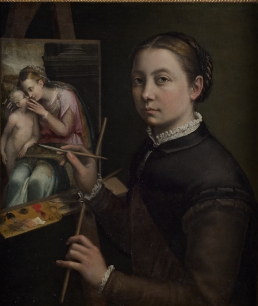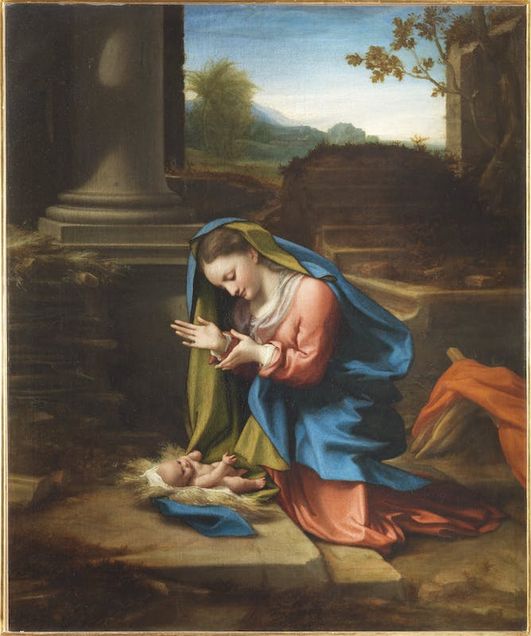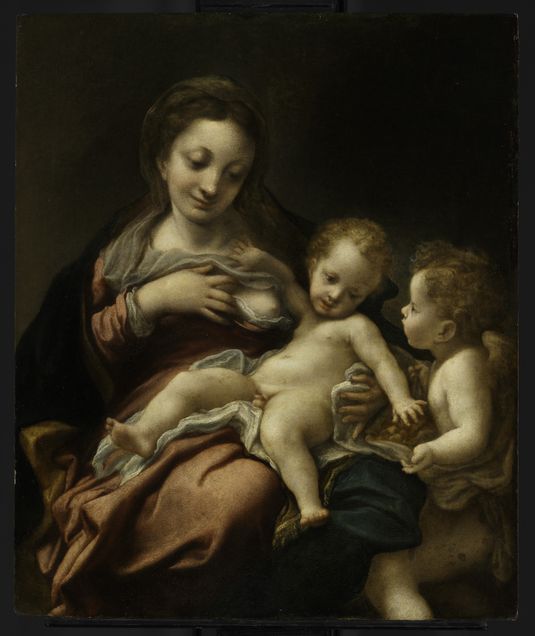Performance and Imitation: Sofonisba Anguissola’s “Self Portrait with Madonna and Child”
by Emma Lazerson

Sofonisba Anguissola (1532?–1625) has been lauded as one of the most prolific portrait painters of the early modern period, but her devotional images have been largely understudied. This essay examines her Self-Portrait with Madonna and Child, a painting showcasing both Sofonisba’s style and that of other artists as a form of emulative adaptation: in her visible imitation, Sofonisba fashions herself as a courtier, while also alluding to her fitness for such a position through the embedded devotional image.
The Self-Portrait with Madonna and Child features Sofonisba gazing out at the audience, painting an image of the Madonna and Child, her brush coloring the flesh of Christ (fig. 1). The Madonna is youthful and idealized with her hand gently cupping the back of a nude Christ Child’s head, while the other delicately rests against his cheek, in preparation for a symbolic nuptial kiss. In painting the Madonna, Sofonisba inserts herself into Boccaccio’s history of illustrious women from his Concerning Famous Women (1374).1 In his text, Boccaccio refers to women from all different stations, but he specifically describes three famous classical artists, including Thamyris, painter of the goddess Diana. She was known for her chastity and was often conflated with the Madonna in the early modern period.2 It is likely that Sofonisba would have read Boccaccio’s text and may have identified with Thamyris.3 By painting the Madonna, Sofonisba places herself in dialogue with Thamyris, indicating her own longing for fame, her own desire for recognition as an artist.4 This desire was further exemplified by the fact that she sent such images to powerful courts throughout Europe, including that of Philip II of Spain, her future employer.5 Such images could have functioned as an informal sort of job interview, in which Sofonisba marketed her skills to appeal to the courts.
To aid her self-promotion, she turned to Baldassare Castiglione’s The Book of the Courtier (1528) for a description of how the ideal courtier could represent herself.6 Castiglione’s work features an open dialogue between various members of the Gonzaga Court in Urbino, but early modern readers viewed the text as prescriptive.7 It is this sort of reading that likely informed Sofonisba’s self-portrayal. In her self-presentation, she goes beyond an austere self-fashioning, directly fitting into one of the ways an ideal courtier could dress according to Castiglione. Sofonisba’s expression in her self-portrait is “grave and sober,” as she wears a plain black dress with a high neckline, which respectively aligns with Castiglione’s description of an ideal courtier as she paints with the most “pleasing” color and shows the “sobriety which the Spanish nation so much observes.”8 She signals key characteristics that Castiglione ascribed to the ideal courtier: modesty, reservedness, diligenza, and sprezzatura—an affected appearance of ease. Her clothes are demure and without frills, and her expression is undemonstrative, indicating her modesty and reservedness. Though her expression is impassive, Sofonisba shows her propensity for labor in her partially rotated pose, steady hold on the brush and maulstick, and tense arm muscles. All are signs emblematic of the diligenza she employs in her art and, presumably, in her life. By relying on the prescriptions of Castiglione in her self-fashioning, Sofonisba presents herself as a courtier before ever working at a court, and she demonstrates her ease of assimilation in this performance as a courtier. Furthermore, her art of painting, which Castiglione esteems as a positive characteristic for a courtier, appears to be done with ease, as shown through the two modes and two styles in which she paints fluidly. In her self-portrayal, Sofonisba paints in a manner established for her other self-portraits, while in the easel painting, she employs the manners of Correggio and Parmigianino. This oscillation is also representative of an affected appearance of ease, a point to which I will return. Her self-fashioning reflects the concerns of Castiglione’s court and her own desire to adapt to such a setting.


Sofonisba portrays herself according to Castiglione’s outline, and the embedded easel painting in the Self-Portrait may further show her ability to assimilate her style to that of other artists, a capability valued in a court painter, which Michael Cole contends Sofonisba aspired to be.9 Assimilation acted as the mechanism by which Sofonisba would be able to become a court artist, as the Spanish sought continuity in their portraits.10 The Madonna and Child is rendered in a style different from the one she uses to portray herself and akin to that of the painters Correggio and Parmigianino. In her early career, Sofonisba would have been exposed to the style of Correggio through her teacher Bernardino Campi, and she may have seen Parmigianino’s work through the large number of prints he disseminated throughout his career.11 Sofonisba’s Madonna resembles the Madonna of Correggio’s Virgin Adoring the Christ Child (fig. 2), borrowing Correggio’s soft portrayal of flesh, rosy cheeks, thick dark hair, and small softened lips. Sofonisba’s Christ Child also adopts Correggio’s blonde, fine curls visible in works such as Madonna and Child with an Angel (fig. 3). This is in contrast to the figures in her early non-devotional genre scenes, such as The Chess Game, in which her sisters are shown in a non-idealized fashion but with a naturalism characteristic of Lombard art.12 Sofonisba’s embedded canvas alludes to Correggio, but her image is not a one-to-one copy of Corregesque style.


While Correggio’s manner is very soft, Parmigianino’s style is much sharper. The limbs of the Virgin closely parallel the long, sinuous body shape of the Madonna from Parmigianino’s Madonna of the Long Neck (fig. 4). The Christ Child is similarly composed of Parmigianino-esque features, with a thinner body and a jutting hip: this infant does not echo the pudgy children of Correggio but instead heightens the sexual nature of Parmigianino’s images. The sexualization of the pose of the Child is further carried out through the nuptial kiss shared with his mother. There is no other image in Sofonisba’s oeuvre that is so sexualized. The chosen subject matter, a nuptial kiss in which the Madonna is at once ‘sposa, madre e figlia’ to Christ as the bridegroom, is unusual for her. In sixteenth-century Italian paintings, such as those by Perugino, Raphael, and Titian, the Madonna was generally shown holding Christ, but they were not usually engaged in a kiss.13 In contrast, Parmigianino’s Mystic Marriage of St. Margaret features a sexual charge between the saint and Christ Child (fig. 5). In the altarpiece, St. Margaret looks longingly and kneels before the Christ Child on his mother’s lap. The infant lightly touches St. Margaret’s shoulder, and she leans close though does not directly kiss the Christ Child. This sexualized religious image was not unusual for Parmigianino, but it was for Sofonisba, who appears to adapt her subject manner and style to be more like Parmigianino’s. Sofonisba’s other devotional images, her Maria Lactans and Holy Family with Saint Anne and Saint John the Baptist, feature rounded and chubby-limbed infants as opposed to the Self-Portrait Christ Child’s bonier body, a common trait of Parmigianino’s infants. In sexualizing the Christ Child, Sofonisba demonstrates her stylistic range, showing her proclivity for adaptation as a form of imitation, as a means of navigating between different forms of grace.
While Sofonisba’s self-portrayal in the Self-Portrait is unornamented, the Madonna’s grace is artificial, following the conventions outlined in Agnolo Firenzuola’s 1548 treatise.14 As Elizabeth Cropper discusses in her article on Parmigianino’s paintings, Firenzuola defined ideal female beauty in specific terms, equating the perfect silhouette with that of a capital.15 As the tenets put forth by Firenzuola were perhaps inspired by Parmigianino’s Madonna of the Long Neck, or vice-versa, there is a capital in the Parmigianino painting, echoing the beauty of Parmigianino’s perfected Madonna. Like Parmigianino, Sofonisba, too, includes a capital next to the Madonna in her Self-Portrait, presumably as an analog for the Madonna’s beauty. The capital’s inclusion acts as a purposeful allusion to the kind of grace promulgated and articulated by Parmigianino and Correggio, as opposed to the less idealized grace of Sofonisba’s own style.16 Her easy navigation between the two distinct types of grace is a kind of performance, for which Castiglione coined a term in his Book of the Courtier: sprezzatura.17
Sofonisba’s self-fashioning as a courtier is a kind of affected performance, but the canvas within the self-portrait can be considered a performance in its own right. Sofonisba not only thinks about the appearance of courtly manners but also about Correggio and Parmigianino’s type of invention. Her imitation is conspicuous, performative. Moreover, the oscillation between styles and inventions heightens the appearance of sprezzatura. As the imitation is visible, the negotiation between her own style and Correggio’s and Parmigianino’s becomes part of the painting’s mission. Sofonisba was not just considering Castiglione’s text as a prescriptive manual for the courtier: she was engaging with and interpreting the text, identifying ways to make her own form of sprezzatura recognizable in her work. I contend that through her emulative adaptation, the demonstration of her ability to assimilate to the style of others, Sofonisba gained a position at the court of Philip II. However, there are still many unanswered questions regarding this work and others like it: What other forms of imitation did Sofonisba practice? How do her devotional images reshape the artist’s oeuvre, including those which are now lost? These questions, among others, provide future avenues of scholarship surrounding this standout Renaissance artist: here’s looking at her.18
____________________
Emma Lazerson received her BA from Emory University in 2022 and is currently a first-year MA candidate in Art History at Case Western Reserve University. Her research focuses on early modern Italian female artists, contextualizing their practices in social, religious, and global theories.
____________________
Footnotes
1. Michael Cole, Sofonisba’s Lesson (Princeton: Princeton University Press, 2019), 22.
2. For an example of this conflation, see MS Français 598, De Mulieribus Claris, Bibliothèque National de France, 1403, Paris.
3. Cole, Sofonisba’s Lesson, 22–25.
4. Cole, Sofonisba’s Lesson, 21.
5. Cole, Sofonisba’s Lesson, 21.
6. Joanna Woods-Marsden, Renaissance Self-Portraiture (New Haven: Yale University Press, 1998), 201.
7. Woods-Marsden, Renaissance Self-Portraiture, 15–17.
8. “I prefer [the courtier] always [in dress] to tend a little more toward the grave and sober rather than the foppish. Hence, I think that black is more pleasing in clothing than any other color; and if not black, then at least some color on the dark side…I would have our Courtier’s dress show that sobriety which the Spanish nation so much observes, since external things often bear witness to inner things.” Baldassare Castiglione, The Book of the Courtier, trans. Charles S. Singleton (Garden City, N.Y.: Doubleday, 1959), 89.
9. There has been little scholarship directly relating to Sofonisba’s imitation. See Maria H. Loh, “New and Improved: Repetition as Originality in Italian Baroque Practice and Theory,” The Art Bulletin 86, no. 3 (2004): 477–504. Loh discusses both the early modern notion of misto, or mixing other styles into one composition. For a discussion of the Spanish interest in copying practices among their court artists, see Cole, Sofonisba’s Lesson, 137.
10. Cole, Sofonisba’s Lesson, 21.
11. See Ilya Sandra Perlingieri, The First Great Woman Artist of the Renaissance (New York: Rizzoli, 1992), 40–41, regarding Sofonisba’s introduction to Correggio’s style.
12. See Andrea Bayer, ed., Painters of Reality: The Legacy of Leonardo and Caravaggio in Lombardy (New Haven: Yale University Press, 2004).
13. In the Middle Ages, Christ and the Madonna as bridegroom and bride was a common theme. In these medieval examples the two actors were usually represented as close in age, rather than as a mother and child, an allegorized union for the church. For examples of the nuptial kiss, see Marilyn Aronberg Lavin, “Art of the Misbegotten: Physicality and the Divine in Renaissance Images,” Artibus et Historiae 30, no. 60 (2009): 225–232.
14. Elizabeth Cropper, “On Beautiful Women, Parmigianino, Petrarchismo, and the Vernacular Style,” The Art Bulletin 58, no. 3 (September 1976): 381–383. Also see Agnolo Firenzuola, On the Beauty of Women, trans. Konrad Eisenbichler and Jacqueline Murray (Philadelphia: University of Pennsylvania Press, 1992).
15. Cropper, “On Beautiful Women,” 381.
16. Regina Stefaniak, “Amazing Grace: Parmigianino’s ‘Vision of Saint Jerome’,” Zeitschrift für Kunstgeschichte 58, no. 1 (1995): 105–115.
17. “…practice in all things a certain sprezzautra, so as to conceal all art and make whatever is done or said appear to be without effort and almost without any thought about it. And I believe much grace comes of this: because everyone knows the difficulty of things that are rare and well done; wherefore facility in such things causes the greatest wonder.” Castiglione, The Book of the Courtier, 32.
18. Here I reference the titles of Perlingieri’s book and Mary Garrard’s “Here’s Looking at Me: Sofonisba Anguissola and the Problem of the Woman Artist,” Renaissance Quarterly 47, no. 3 (Autumn 1994): 556–622. These authors were some of the first modern scholars to write about Sofonisba. This essay is indebted to their contributions.